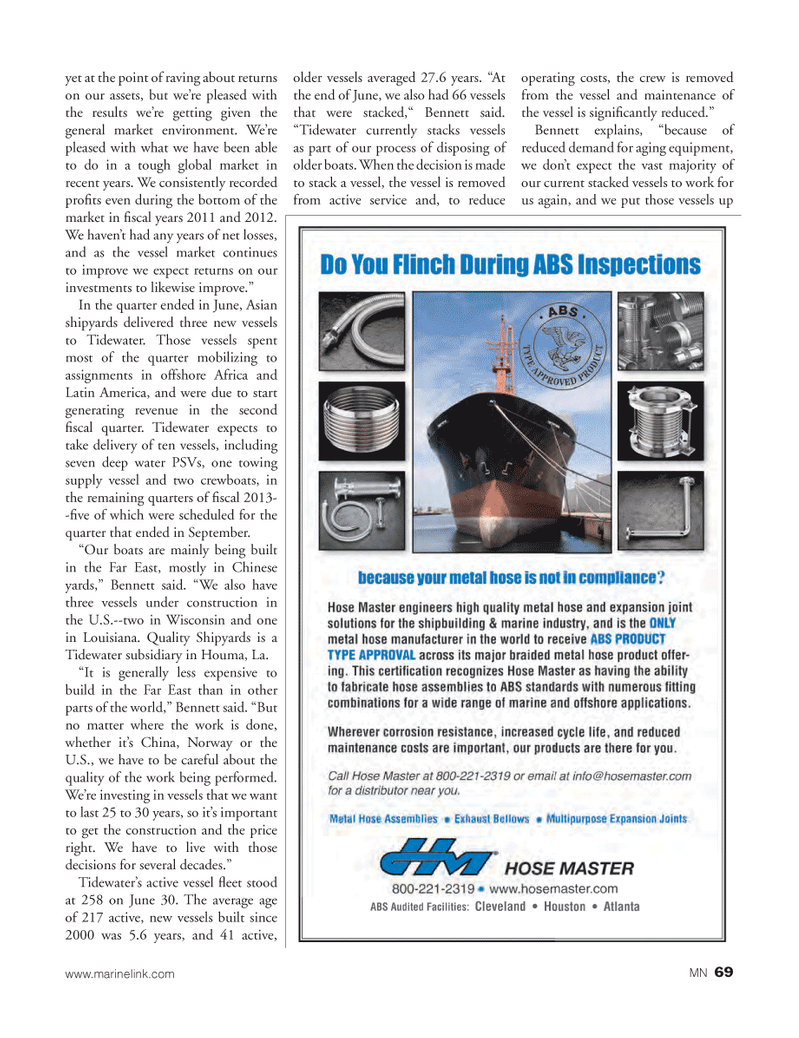
Page 69: of Marine News Magazine (November 2012)
Workboat Annual
Read this page in Pdf, Flash or Html5 edition of November 2012 Marine News Magazine
yet at the point of raving about returns on our assets, but we?re pleased with the results we?re getting given the general market environment. We?re pleased with what we have been able to do in a tough global market in recent years. We consistently recorded pro ts even during the bottom of the market in scal years 2011 and 2012. We haven?t had any years of net losses, and as the vessel market continues to improve we expect returns on our investments to likewise improve.? In the quarter ended in June, Asian shipyards delivered three new vessels to Tidewater. Those vessels spent most of the quarter mobilizing to assignments in offshore Africa and Latin America, and were due to start generating revenue in the second scal quarter. Tidewater expects to take delivery of ten vessels, including seven deep water PSVs, one towing supply vessel and two crewboats, in the remaining quarters of scal 2013-- ve of which were scheduled for the quarter that ended in September. ?Our boats are mainly being built in the Far East, mostly in Chinese yards,? Bennett said. ?We also have three vessels under construction in the U.S.--two in Wisconsin and one in Louisiana. Quality Shipyards is a Tidewater subsidiary in Houma, La. ?It is generally less expensive to build in the Far East than in other parts of the world,? Bennett said. ?But no matter where the work is done, whether it?s China, Norway or the U.S., we have to be careful about the quality of the work being performed. We?re investing in vessels that we want to last 25 to 30 years, so it?s important to get the construction and the price right. We have to live with those decisions for several decades.? Tidewater?s active vessel eet stood at 258 on June 30. The average age of 217 active, new vessels built since 2000 was 5.6 years, and 41 active, older vessels averaged 27.6 years. ?At the end of June, we also had 66 vessels that were stacked,? Bennett said. ?Tidewater currently stacks vessels as part of our process of disposing of older boats. When the decision is made to stack a vessel, the vessel is removed from active service and, to reduce operating costs, the crew is removed from the vessel and maintenance of the vessel is signi cantly reduced.? Bennett explains, ?because of reduced demand for aging equipment, we don?t expect the vast majority of our current stacked vessels to work for us again, and we put those vessels up MN 69www.marinelink.com MNNov2012 Layout 66-81.indd 69MNNov2012 Layout 66-81.indd 6911/7/2012 11:13:34 AM11/7/2012 11:13:34 AM

 68
68

 70
70
